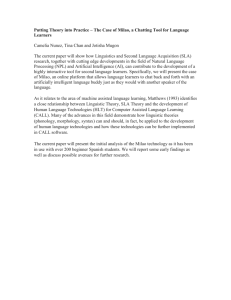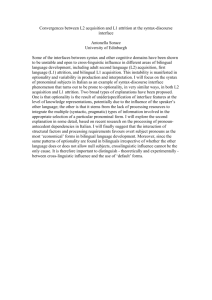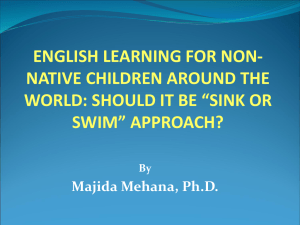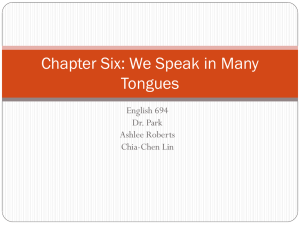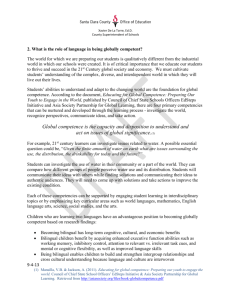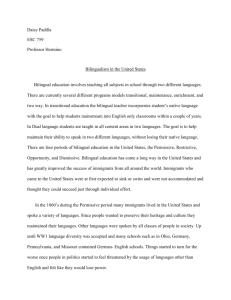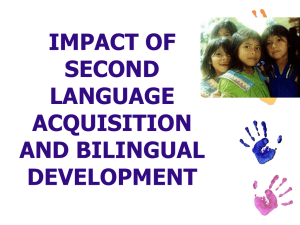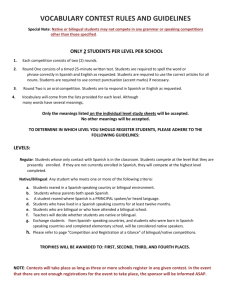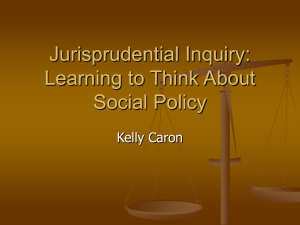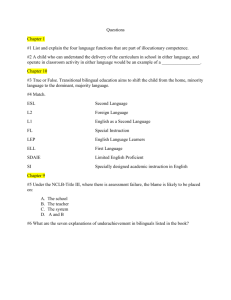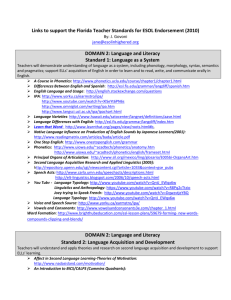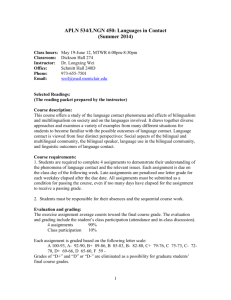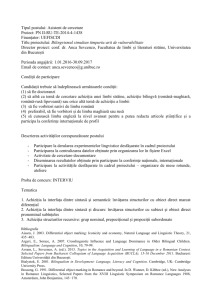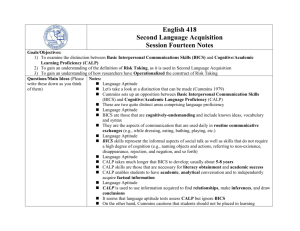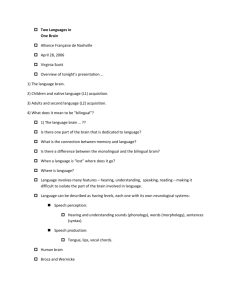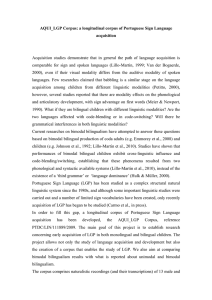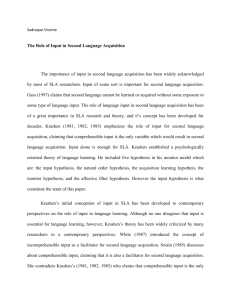historical traditions of bilingualism
advertisement
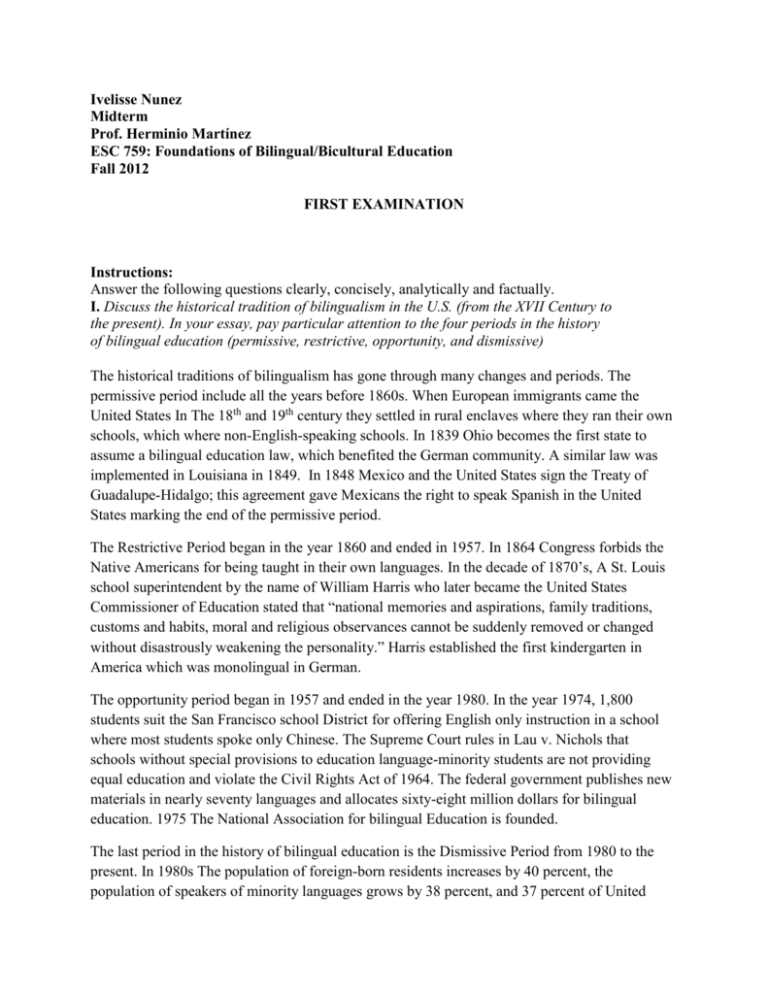
Ivelisse Nunez Midterm Prof. Herminio Martínez ESC 759: Foundations of Bilingual/Bicultural Education Fall 2012 FIRST EXAMINATION Instructions: Answer the following questions clearly, concisely, analytically and factually. I. Discuss the historical tradition of bilingualism in the U.S. (from the XVII Century to the present). In your essay, pay particular attention to the four periods in the history of bilingual education (permissive, restrictive, opportunity, and dismissive) The historical traditions of bilingualism has gone through many changes and periods. The permissive period include all the years before 1860s. When European immigrants came the United States In The 18th and 19th century they settled in rural enclaves where they ran their own schools, which where non-English-speaking schools. In 1839 Ohio becomes the first state to assume a bilingual education law, which benefited the German community. A similar law was implemented in Louisiana in 1849. In 1848 Mexico and the United States sign the Treaty of Guadalupe-Hidalgo; this agreement gave Mexicans the right to speak Spanish in the United States marking the end of the permissive period. The Restrictive Period began in the year 1860 and ended in 1957. In 1864 Congress forbids the Native Americans for being taught in their own languages. In the decade of 1870’s, A St. Louis school superintendent by the name of William Harris who later became the United States Commissioner of Education stated that “national memories and aspirations, family traditions, customs and habits, moral and religious observances cannot be suddenly removed or changed without disastrously weakening the personality.” Harris established the first kindergarten in America which was monolingual in German. The opportunity period began in 1957 and ended in the year 1980. In the year 1974, 1,800 students suit the San Francisco school District for offering English only instruction in a school where most students spoke only Chinese. The Supreme Court rules in Lau v. Nichols that schools without special provisions to education language-minority students are not providing equal education and violate the Civil Rights Act of 1964. The federal government publishes new materials in nearly seventy languages and allocates sixty-eight million dollars for bilingual education. 1975 The National Association for bilingual Education is founded. The last period in the history of bilingual education is the Dismissive Period from 1980 to the present. In 1980s The population of foreign-born residents increases by 40 percent, the population of speakers of minority languages grows by 38 percent, and 37 percent of United States residents report some difficulty with English. 1980 The Mariel boatlift brings younger and poorer Cubans to Dade County, Florida. Dade voters pass the anti-bilingual ordinance prohibiting any voluntary expenditure “for the purpose of utilizing any language other than English, or promoting any culture other than that of the U.S.” The measure is repealed in 1993 but the harsh language of the ordinance exposes growing anti-immigrant sentiment. 1994 California passes Proposition 187, making it illegal for children of undocumented immigrants to attend public schools. The federal courts rule that Proposition 187 is unconstitutional. 1998 California voters overwhelmingly (61 to 39) approve Proposition 227, an initiative that eliminates the state’s bilingual education programs and requires that all instruction be conducted in English. 2000 Arizona passes its version of English-only Laws, Proposition 203. II. Discuss the optimal conditions for Second Language Acquisition. (Cite the “Magic 7” components.) In order for second language acquisition to happen the student must be learning in a “Low anxiety environment” that is accepting and where the student feels confortable to speak. “Comprehensible Input” is also very important, Krashen, 1982, states that A second language is not acquired by direct instruction in the rules of the language, by using the language in meaningful contexts. Krashen also added that students will acquire a second language only if they receive comprehensible input in it. Talk becomes comprehensible input to students through context and reference to background knowledge (Krashen, 1985) or context-embedded and cognitively undemanding experiences. Cummins claims that talk is not enough; to succeed in school, ELL students need more than conversational fluency; they need to develop the cognitive and academic skills required for learning academic subject matter. Another condition for second language acquisition is “Communication Focus”. ESL instruction should focus on oral and written communication. “Contextualize language” and focus on pronunciation, grammar and vocabulary. “Error acceptance” is an important step for a child to go from BICS to CALP. Both Ells and ESL instructors must have “Respect for Language Acquisition Stages” in order to reach the proficiency needed to function in decontextualized, academic settings. Finally, “Teacher as Facilitator” to provide testing, assignment, assessments and feedback. III. Discuss the four stages of language acquisition: Preproduction: This stage is characterized by Basic Interpersonal Communication Skills (BICS). In this stage, students are not speaking the new language: the child relies on physical responses only, there is no speech production and the comprehension minimal. The responses are limited to one or twoword. Students are dependent upon modeling, visual signs and context clues to obtain and convey meaning. The focus is comprehension as students develop listening strategies which will later form the basis for production. Students communicate with gestures and actions. This period last from 2 weeks to 2 months. Early Production: This stage is also characterized by Basic Interpersonal Communication Skills (BICS). After an initial listening phase, students begin to produce words that they have heard often. The student verbalizes words in isolation. Students begin to answer yes or no to specific questions. They may also answer in one-word responses that utilize a familiar vocabulary word. Activities are designed to produce vocabulary which they already understand. This period last 2 to 4 months. Speech Emergence: . This is the simple sentence stage. The Basic Interpersonal Communication Skills (BICS) are still in development. Students have now acquired a limited vocabulary and respond in short sentences, and later in longer sentences. The student produces whole sentences but makes basic grammatical errors. The students at this state functions on a social level; they are able to respond to literal questions and questions which are made comprehensible. This stage last anywhere from 1 to four years. Intermediate Fluency: CALF proficiency begins at this stage. Students begin to emerge in conversations and produce full sentences and connected narratives. Students are challenged to produce responses that acquire creativity, critical thinking skills, and complete sentence structures. More advanced reading and writing activities are incorporated into lessons. The student challenges cognitive processes, asks why questions soliciting opinion, judgment, prediction, hypothesis, and inference. This period can last anywhere from 3 to 5 years.

